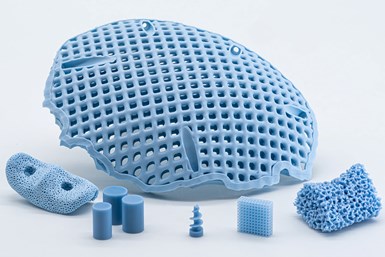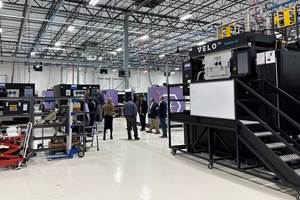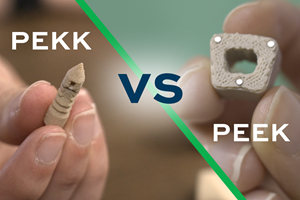Lithoz Offers Improved Ceramic Material for 3D-Printed Bone Replacements
The company says the 3D printed, patient-specific parts made of hydroxyapatite are well suited for bone replacements in the medical and dental field.
Share
Read Next
LithaBone HA 480 is a greatly improved human bone-like ceramic material which can be used to create distinctly blue complex parts. Photo Credit: Lithoz
Lithoz has developed the LithaBone HA 480, a substantially improved bioresorbable ceramic bone graft substitute. The company says the material was developed in intensive collaboration with users of previous Lithoz bone graft substitutes.
The 3D printed patient-individual parts made of hydroxyapatite are well suited for bone replacements in the medical and dental field. The company says substantial improvements include mechanical properties, higher wall thickness, possible geometries, size of the lattice structures and processability.
The development goal was to make the material more economically viable and the use of 3D printing for bone replacements even more effective. The company says the result is a greatly improved human bone-like ceramic material which can be used to create distinctly blue complex parts.
In medicine, ceramics are considered well suited materials for devices and implants due to their biocompatibility, low thermal conductivity and lighter intrinsic weight. Most importantly, however, certain ceramics can be resorbed by the body, eliminating the risks connected to second surgeries.
The wide range of bone structures in the body necessitate that ceramic materials for bone replacement fully cover this range and are both biocompatible and resorbable. The planned interaction of the bone substitute material with adjacent bone and tissues depends on the optimized design of geometries which, accordingly, determines clinical success as bone regrows along the material’s guide structures and the ceramic dissolves in the body.
LithaBone HA 480 offers several major improvements, including significantly higher wall thicknesses, which is a key requirement for versatility reasons. With LithaBone HA 480, previous maximum wall thicknesses of <1.6mm (LithaBone HA 400) have been increased to 10 mm, while minimum wall thicknesses required have been reduced even further, which significantly broadens the range of applications.
The material also enables more precise imaging accuracy of fine structures — in line with the strengths of lithography-based ceramics manufacturing (LCM). One clear goal was to offer a higher level of ultraprecise resolutions and highly complex structures when working with hydroxyapatite. It is said LithaBone HA 480 shows strongly reduced overpolymerization with a simultaneously improved depth of cure, resulting in a simpler selection of build parameters and a significantly more stable manufacturing process.
The material also offers a 10-fold longer shelf life, which helps eliminate the previous obstacle of previous materials’ short shelf life that impacted the availability required for urgent surgical interventions. Parts are also significantly easier to clean, making up valuable time during often vital medical interventions. According to the company, experienced users have confirmed significantly faster and easier cleaning processes thanks to an improved binder composition.
- Lithoz also developed the Lithoz CeraFab S65 ceramic 3D printer that features plug-and-play scalability which can drive complex, 3D-printed high-performance ceramic applications to industrial levels.
- With the acquisition of CerAMing and its LSD printing technology, Lithoz says it now fully covers all strategically relevant market potentials in ceramic 3D printing.
- Lithoz’s CeraMax Vario V900 3D printer can produce large ceramic components with thick walls and full densities using oxide and non-oxide ceramics.
- Read Peter Zelinski’s take on the some of the most important developments seen at Formnext 2022, including 3D printing on Lithoz’s photopolymer-based platform which enabled production of a ceramic pin at over 400 pieces per build.
Related Content
Zeda AM Production Plant in Ohio Now Open — Thoughts on the New Facility
73,000-square-foot metal powder bed fusion plant includes extensive machining capability plus separate operational models for serving medical versus other businesses.
Read MoreDurable, Waterproof 3D Printed Casts: The Cool Parts Show #58
Recovering from an injury with an ActivArmor cast means that patients can exercise, bathe and live life while they heal. We get a firsthand look at the solution in this episode of The Cool Parts Show.
Read MoreUnderstanding PEKK and PEEK for 3D Printing: The Cool Parts Show Bonus
Both materials offer properties desirable for medical implants, among other applications. In this bonus episode, hear more from Oxford Performance Materials and Curiteva about how these companies are applying PEKK and PEEK, respectively.
Read MoreActivArmor Casts and Splints Are Shifting to Point-of-Care 3D Printing
ActivArmor offers individualized, 3D printed casts and splints for various diagnoses. The company is in the process of shifting to point-of-care printing and aims to promote positive healing outcomes and improved hygienics with customized support devices.
Read MoreRead Next
4 Ways the Education and Training Challenge Is Different for Additive Manufacturing
The advance of additive manufacturing means we need more professionals educated in AM technology.
Read MoreHybrid Additive Manufacturing Machine Tools Continue to Make Gains (Includes Video)
The hybrid machine tool is an idea that continues to advance. Two important developments of recent years expand the possibilities for this platform.
Read MoreAt General Atomics, Do Unmanned Aerial Systems Reveal the Future of Aircraft Manufacturing?
The maker of the Predator and SkyGuardian remote aircraft can implement additive manufacturing more rapidly and widely than the makers of other types of planes. The role of 3D printing in current and future UAS components hints at how far AM can go to save cost and time in aircraft production and design.
Read More






















